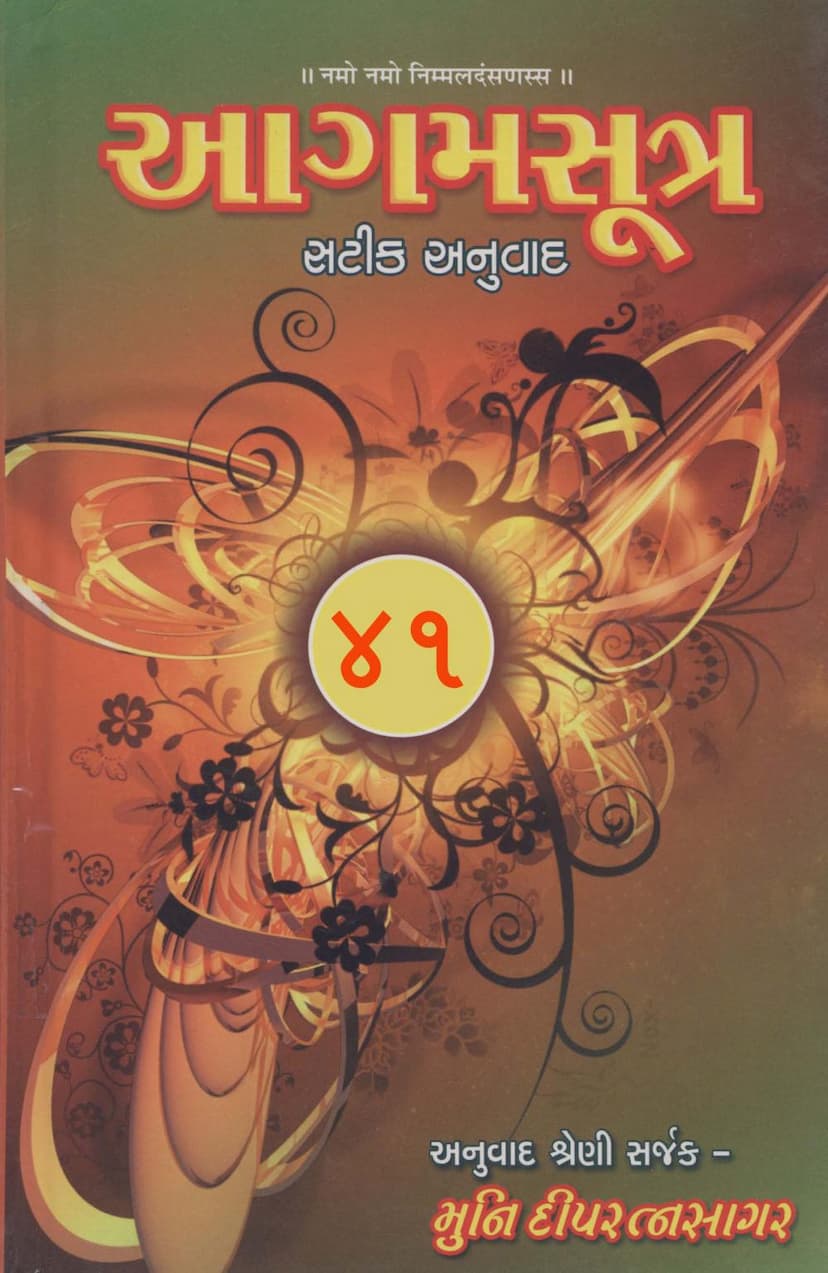Agam Satik Part 41 Anuyogdwar Sutra Gujarati Anuwad
Added to library: September 1, 2025

Summary
The provided text is a Gujarati translation and commentary of the Jain Agam text Anuyogdwar Sutra, which is the 41st part in a series titled Agam Satik Part 41. The translation and commentary are attributed to Muni Deepratnasagar, with publication by Deepratnasagar.
Here's a breakdown of the content from the provided pages:
-
Pages 1-18: These pages are primarily introductory and acknowledgments.
- Title Page (Page 1): "Agam Sutra Satik Anuvad, Bhag 41, Anuyogdwar Anuvad Shreni Sarjak - Muni Deepratnasagar." (Jain Agam Sutra with Commentary Translation, Part 41, Anuyogdwar Translation Series Creator - Muni Deepratnasagar).
- Obeisance and Publisher Details (Pages 2-3): Expresses respect to various Jain saints and organizations, mentions the author, publisher, contact information, and lists the contents of this specific volume (Anuyogdwar Sutra - Chapter 2, full Anuyogdwar Sutra, with translation and commentary).
- Acknowledgments (Pages 4-11): A significant portion of the initial pages are dedicated to expressing gratitude to numerous individuals and organizations who provided financial and inspirational support for the publication of this extensive series of Agam translations. This includes references to revered Acharyas like Acharya Shri Prakcharishwarji M. and Acharya Shri Dewesagar Surishwarji M., and various Jain sanghs (communities) and trusts from different cities.
- Publisher's Publications (Pages 10-18): This section provides a detailed list of other published works by Muni Deepratnasagar and his organization, covering various categories of Jain literature:
- Original Agams (45 + 4 optional = 49 Agams).
- Gujarati translations of Agams.
- Commentaries on Agams (Agam Sutrani Satik).
- Indexes and thematic guides for Agams.
- Jain dictionaries (Agam Kosha).
- Hindi translations of Agams.
- Agam Kathānuyog (stories and narratives from Agams).
- Agam Mahapujan Vidhi (rituals for worship of Agams).
- Grammar literature.
- Commentary literature (Vyakhyan Sahitya).
- Tattvasutras (scriptures on Jain principles).
- Aradhana literature (on spiritual practices).
- Ritual literature (Vidhi Sahitya).
- Pujan literature (worship rituals).
- Chakras (diagrams).
- Devotional literature (Jin Bhakti Sahitya).
- Miscellaneous literature.
- Shravak studies literature.
-
Pages 19 onwards: This section begins the actual translation and commentary of the Anuyogdwar Sutra.
- Introduction to Anuyogdwar Sutra (Page 19): It explains that the text is known as "Anu-mokashamak" in Prakrit and "Anuyogadwar" in Sanskrit and Gujarati. Its primary subject is "Anuyog" (commentary or exposition), but it also covers topics like Aavashyak (essential duties), Shrut (scripture), Skandh (sections), Upakram (introduction), Anupurvi (succession), Naam (names), Praman (valid cognition), Samavataar (classification), Nikshep (categories), Anugam (analysis), and Nay (viewpoints). It notes the absence of commentaries like Niryukti or Bhashya, but mentions the existence of a Churni and extensive commentaries by Haribhadrasuri and Malladharin Hemchandracharya. Anuyogdwar is considered a "key scripture" as it provides the foundational principles for interpreting other Agams. It is currently recognized as a "Chulika Sutra" (a supplementary or secondary scripture).
- Starting with the Five Types of Knowledge (Page 19 onwards): The translation begins by enumerating the five types of knowledge in Jainism:
- Abhinibodhika Jnan (Mati Jnan): Knowledge gained through senses and mind.
- Shrut Jnan: Knowledge gained through listening or reading scriptures.
- Avadhi Jnan: Clairvoyant knowledge of form.
- Manahparyav Jnan: Telepathic knowledge of others' thoughts.
- Keval Jnan: Omniscient knowledge.
- Detailed Explanations (Pages 19-68): The text then delves into the characteristics and classifications of each type of knowledge, followed by the introduction of the concept of "Anuyog." It discusses the significance of Shrut Jnan as the primary means of accessing and transmitting Jain teachings. The text then moves on to explain the different types of Anuyog and how they are applied, detailing various categories and analytical frameworks like Nikshep, Upakram, and Nay.
- Focus on Aavashyak (Pages 21-35): A substantial portion of the text focuses on the "Aavashyak" (essential duties) as part of the Anuyog. It categorizes Aavashyak into four types: Naam Aavashyak, Sthapana Aavashyak, Dravya Aavashyak, and Bhav Aavashyak, providing detailed explanations and examples for each.
- Further Analysis of Shrut (Pages 35-40): The text continues to discuss Shrut Jnan, its types (Naam, Sthapana, Dravya, Bhav), and then moves to the concept of "Skandh" (sections of scripture), again classifying it into Naam, Sthapana, Dravya, and Bhav.
- Naya and Their Application (Pages 40-52): A significant portion is dedicated to explaining the seven Nayas (viewpoints or logical principles) and how they are applied in understanding reality. This includes detailed discussions on how different Nayas interpret concepts like "Aavashyak" and "Skandh" in relation to "Anupayukt" (unapplied) souls.
- Detailed Analysis of various concepts: The text meticulously breaks down concepts like:
- Aavashyak: Its types (Naam, Sthapana, Dravya, Bhav) and their sub-categories, including elaborate examples for Naam and Sthapana.
- Shrut: Its types (Naam, Sthapana, Dravya, Bhav) and the nuances within Dravya Shrut based on different Nayas.
- Skandh: Its classification into Naam, Sthapana, Dravya, and Bhav, with further sub-divisions based on Nayas and various physical attributes (such as Sachiit, Achitt, Mishrit).
- Kaal (Time): Its measurement and classification.
- Various other concepts: The text continues to systematically analyze other core Jain philosophical and analytical concepts within the framework of Anuyogdwar.
In essence, this volume is a deep dive into the Anuyogdwar Sutra, a foundational text in Jainism for understanding the structure and interpretation of the Agams. It aims to provide a comprehensive, translated, and analyzed version of this complex scripture, making it accessible to a wider audience. The extensive acknowledgments highlight the significant effort and collaborative support behind this publication.